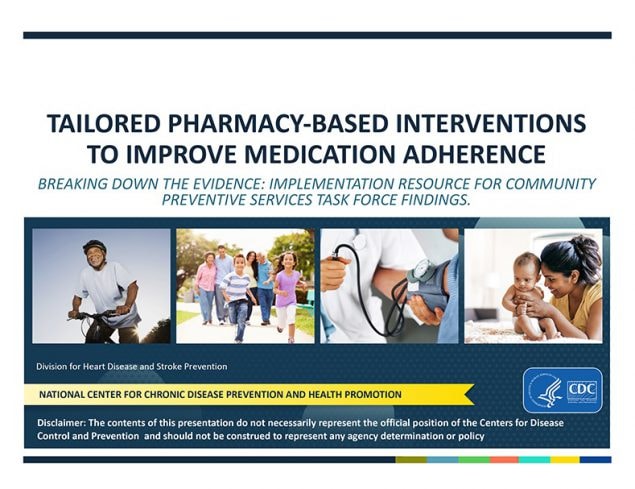Tailored Pharmacy-Based Interventions to Improve Medication Adherence
In The Community Guide, the Community Preventive Services Task Force (CPSTF) recommends tailored pharmacy-based interventions to support adherence to medications prescribed to prevent cardiovascular disease (CVD).1 The CPSTF found these interventions to be cost-effective for preventing CVD.1
The Surgeon General’s 2020 Call to Action to Control Hypertension also encourages the use of supportive strategies for medication adherence, including pharmacists as integral members of hypertension care teams.2
Public health practitioners and state and local health departments can support use of the CPSTF recommendation by promoting and helping pharmacies implement tailored pharmacy-based interventions.
Tailored pharmacy-based interventions aim to help patients who are at risk for CVD take their medications as prescribed. Interventions include the following:
- Assessment—Interviews or assessment tools are used to identify adherence barriers.
- Tailored guidance and services—A pharmacist use the results obtained from the patient’s assessment to develop and deliver tailored guidance and services that aim to remove or reduce identified barriers.
Important Definitions
Medication nonadherence is when a patient does not take a prescribed medicine or follow the provider’s instructions for taking the medicine. Barriers that prevent patients from taking their medications can appear at the patient, provider, or health system level. Nonadherence is associated with uncontrolled blood pressure and higher rates of hospital admissions.4
The Pharmacists’ Patient Care Process was established by the Joint Commission of Pharmacy Practitioners to help pharmacists deliver patient care and services in a consistent way.5
- Tailored guidance includes focused medication counseling or motivational interviewing sessions.
- Tailored services include one or more of the following: patient tools, such as pillboxes, medication cards, and calendars; medication refill synchronization; and enhanced follow-up.
Interventions may be set in community or health system pharmacies. They may include additional components, such as patient education materials or communication between the pharmacist and the patient’s primary care provider. Interventions may be used alone, or as part of a broader intervention to reduce patients’ cardiovascular disease risk.
Tailored pharmacy-based interventions address barriers to medication adherence by examining the factors that affect a person’s ability to take their medications. These barriers may be complex and include factors related to socioeconomics, health care system structures and processes, severity of co-occurring medical conditions, complexity of medication and nonmedication therapies, and patient concerns.3
Factors that affect a patient’s medication adherence may include:
- Medication cost.
- Busy schedules that make it hard to remember to take medications consistently.
- Ease of scheduling appointments.
- Time needed to schedule and attend appointments.
- Ease and comfort level of communicating with the pharmacist or other providers.
- Understanding when and how often to take medications.
- Ability to sync medications and receive automated 30-day or 90-day refills.
- Health condition severity and beliefs about their condition.
- Expectations around possible effects of the medication.
These factors may be intensified by a lack of health care and pharmacy access in the community; lack of trust and effective communication with providers; and limited patient involvement in shared decision-making.
Studies have shown that patients who were adherent to their antihypertensive medications were 30% to 45% more likely to achieve blood pressure control compared to those who were not.6,7
Nonadherence to medications to prevent CVD has been associated with a significant increase in the risk of premature death from any cause, CVD death, hospitalization for heart attack or heart failure, and coronary revascularization procedures.8
Strategies that Support the Pharmacists’ Patient Care Process and Tailored Pharmacy-Based Interventions
The Joint Commission of Pharmacy Practitioners developed the Pharmacists’ Patient Care Process to address medication nonadherence for chronic diseases. Steps in the process (collect, assess, plan, implement, follow-up, and monitor) closely align with how a pharmacist selects tailored actions to remove or reduce patient adherence barriers.

Use the tools and resources below to help identify patient populations, assess facilitators and barriers, and implement the interventions.
Tailored, pharmacy-based interventions may be implemented as one component of the broader Pharmacists’ Patient Care Process [PDF – 2 MB]. Strategies that support the Pharmacists’ Patient Care Process include medication therapy management, the appointment-based model, collaborative practice agreements, and text messaging.
- Medication therapy management (MTM)9 includes a broad range of health care services provided by pharmacists—the medication experts on a patient’s health care team. It allows pharmacists to actively manage patients’ medications and identify, prevent, and resolve medication-related problems. This support helps patients get the most benefit from their medications. MTM services include medication therapy reviews, pharmacotherapy consults, anticoagulation management, immunizations, health and wellness programs, and many other clinical services.
- The appointment-based model (ABM)10 is a patient-focused care model that can help patients take their medications, make a pharmacy’s workflow more efficient, and prevent problems before patients arrive at the pharmacy. Patients enrolled in the ABM have a designated appointment day to pick up all medications. Pharmacy staff call patients before their appointment to identify any changes to their medications and confirm that each prescription should be refilled. The ABM shifts the pharmacy staff’s focus from passively filling prescriptions at the request of the patient on an unaligned schedule to proactively synchronizing a pick-up date for chronic medicines. Staff also review the patient’s medications each month to ensure that they are getting the correct medications and to identify any potential problems.
- A pharmacist collaborative practice agreement (CPA)11 is a formal agreement between prescriber(s) and pharmacist(s). A CPA allows licensed health care providers to make diagnoses, supervise patient care, and refer patients to pharmacists. Pharmacists are then allowed to perform specific patient care functions, such as renewing prescriptions, modifying medication therapy according to the protocol, and ordering lab tests.
- Text messaging12 is available on mobile devices and is used widely by people in all age and socioeconomic groups. It can be used to communicate health information to patients to improve medication adherence.
The benefits and considerations of each of these strategies are outlined in the table below.
Table 1. Strategies that Support The Pharmacists’ Patient Care Process and Tailored Pharmacy-Based Interventions
Considering the Costs and Benefits of Implementation
The CPSTF found these tailored pharmacy-based interventions to be cost-effective in preventing CVD among patients with CVD risk factors. They also found evidence that among patients with existing CVD, the cost savings from averted health care exceeded the costs of implementation.
CVD is a major driver of health care costs in the United States—with over $363.4 billion going toward health care services, medications, and lost productivity due to premature death each year.13
The implications of medication nonadherence are widespread and have financial impacts on health systems, providers, payers, and most importantly, patients. In the United States, the costs of nonadherence to prescribed medications are high and place significant financial strains on the health care system as a whole.14
Medication nonadherence is associated with worse health outcomes and higher health care costs among people with CVD or CVD risk factors.14-17 In one study, higher adherence to prescribed medications for congestive heart failure, high blood pressure, and high LDL cholesterol levels reduced annual health care spending per person by an estimated $7,800, $3,900, and $1,250, respectively, compared to patients with poorer adherence.17
Tailored pharmacy-based interventions to improve medication adherence among patients with CVD risk factors help address growing health care costs. These interventions lead to cost savings from reductions in outpatient primary care and specialist visits, hospitalizations, and emergency department use.18 The full economic impact of implementing these interventions for key partners and participants involved in the delivery, payment, and receipt of these interventions have been largely unexplored by researchers.
As state and local health departments consider introducing or expanding these interventions in their communities, an important first step is to recognize and convene partners involved in implementing the interventions to ensure greater efficiencies, better health, and cost savings. By considering each key player’s role in terms of potential costs and benefits, state and local health departments and their partners may better understand how each may facilitate their implementation and be affected by them.
The role and implementation considerations for key players involved in the delivery, payment, and receipt of tailored pharmacy-based interventions are outlined in the table below.
Table 2. Implementation Considerations for Key Partners and Participants
CDC and Partner Tools and Resources

Use this six-slide PowerPoint presentation and accompanying talking points to help implement Tailored Pharmacy-Based Interventions to Improve Medication Adherence [PPT–1.5 MB].
This presentation summarizes the concepts discussed on this web page.
The tools and resources listed in this section offer steps that public health practitioners and state and local health departments may take.
Identify
Identify patient populations that need help. For example, practitioners and health departments can
- Map populations with high medication nonadherence rates.
- Measure medication adherence in a population with high blood pressure. The proportion of days covered (PDC) is the leading method used to calculate medication adherence at the population level. A population is considered adherent if 80% of people have access to their medications for at least 80% of days in a defined study period (e.g., 80% of 365 days).
Assess
Assess facilitators and the barriers to implementing tailored pharmacy-based interventions. For example, practitioners and health departments can
- Identify pharmacies that offer tailored pharmacy-based interventions or supporting strategies or pharmacies that are interested in implementing these services.
- Determine what factors help patients access and enroll in pharmacies that provide MTM, ABM, or medication synchronization—and what factors prevent access.
Act
Act to implement tailored pharmacy-based interventions with strategies that complement the CPSTF recommendation. For example, practitioners and health departments can
- Share information with pharmacy partners and support ABM and medication synchronization.
- Promote team-based care through MTM and other tailored pharmacy-based interventions.
Disclaimer
Website addresses of nonfederal organizations are provided solely as a service to our readers. Provision of an address does not constitute an endorsement by the Centers for Disease Control and Prevention (CDC) or the federal government, and none should be inferred. CDC is not responsible for the content of other organizations’ web pages.
